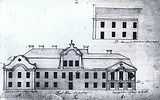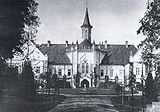Dzików Castle
| Dzików Castle in Tarnobrzeg | |
|---|---|
| Zamek Dzikowski w Tarnobrzegu | |
 Front view | |
| Former names | Residence of the Tarnowski Family |
| Alternative names | Tarnowski Family Castle in Dzików, Dzików Palace in Tarnobrzeg |
| General information | |
| Type | castle |
| Architectural style | neogothic (1830-1927), neobaroque (current) |
| Location | 50°34'46"N 21°40'32"E, Tarnobrzeg, Poland |
| Construction started | end of 14th century |
| Completed | 15th century |
| Renovated | 1830, 1931 |
| Demolished | 1809 (Napoleonic war) |
| Owner | Ossoliński family (since 15th century), Tarnowski family (1522-1945), State Treasury (Skarb Państwa) (since 1945) |
| Design and construction | |
| Architect | Franciszek Maria Lanci (1830), Wacław Krzyżanowski (1931) |
Dzików Castle in Tarnobrzeg, or Tarnowski Family Castle in Dzików (Polish: Zamek Dzikowski w Tarnobrzegu) is a 15th-century (or perhaps a 14th-century) castle with the park complex and gardens, located in Tarnobrzeg, Poland.[1]
Dzików Confederation
The Castle was a site of Dzików Confederation of 5 November 1734, led by Adam Tarło, starosta from Jasło, organized in order to reinstate Stanisław Leszczyński as a king of Poland after the death of August II the Strong. However, Leszczyński resigned his command over the confederation not believing in its success against the superior Saxon and Russian armies. He limited himself only to calls for support from France, Sweden, Turkey and Prussia, but ultimately did not receive any. As a result, Leszczyński consented to abdicate on 26 January 1736; and, as a token of gratitude, received the perpetual right to use the royal title. Dzików Confederation ended in failure.
Art collection

Over the years, the Tarnowski family acquired an impressive art collection housed in the Castle. In the 19th century, there were 250 paintings there, among others of Titian, Rubens, Rembrandt, Jacek Malczewski, and Jan Matejko. Apart from the paintings there were also valuable prints there including the oldest copy of the "Polish Chronicle" of Gallus Anonymus, manuscript "Pan Tadeusz" of Adam Mickiewicz, the first Bogurodzica copy, the original Chronicles of Wincenty Kadłubek and Articles of association Wiślicki. Still, with world war, a matter of the image of Rembrandt was famous "Lisowczyk". One of the most valuable images in Poland was found in Dzikovia Tarnowski collections. In 1910 was left sold and taken away to New York, in spite of protests of the public opinion. During the war priceless treasure of the national and European culture were left carefully hidden in Dzików, as well as deposited in the National Museum in Warsaw and Ossolineum in Lwów. Later all sorts state institutions seized them, e.g. they are in a Łańcut castle close 500 exhibit items around Dzikowia, and in the Rzeszów museum over 80. The deposited part was only left scarce in the West, quite a lot however it went missing without trace with eastern areas seized by Soviet.
In 1974, a treasure chest was discovered in the basements of the palace consisting of old collections of silver with a considerable number of precious Polish artifacts. The whole lot was transported to the Castle in Łańcut.
Currently
From 2007, the palace was under renovation. Roofing was replaced, new foundations were laid, castle basements were repaired. For the first time it is now possible to view there three new exhibitions: "Ancient history of Tarnobrzeg", "Ceramics of Miechocin" and "History of the castle in Dzikovia".
In the near future (2011), the entire collections of the Historical Museum of the City of Tarnobrzeg (Polish: Muzeum Historyczne Miasta Tarnobrzega) will be moved to the castle. The Museum, under the direction of Adam Wójcik and patronage of the City of Tarnobrzeg, was established there in 2009.
Archival photographs
-

1775-1834
-

1835-1912
-

1913 - 1927
-

1927
-

1930
References
- ↑ History of the Dzików Castle with archival photographs at Dzikowia magazine, 10-12, 2007, No 32; featuring articles by Aleksandra Janas, Adam Wójcik-Łużycki, and Michał Marczak
Bibliography
- Janas A., Wójcik A. - Zamek Tarnowskich w Dzikowie
See also
- Dominican Church and Convent of Assumption of Mary in Tarnobrzeg - around 1 km from the Castle
- Church of Our Lady of Perpetual Help in Tarnobrzeg - around 1 km from the Castle
- Tarnowski family
External links
| Wikimedia Commons has media related to Dzikovia Castle in Tarnobrzeg. |
Coordinates: 50°34′46″N 21°40′32″E / 50.5794°N 21.6756°E
| ||||||||||||||||||||||||||